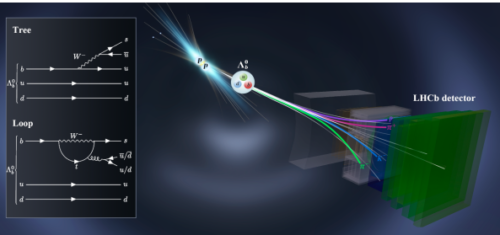2025-04-08 中国科学院(CAS)
<関連情報>
- https://english.cas.cn/newsroom/research_news/phys/202504/t20250409_1040853.shtml
- https://arxiv.org/abs/2503.16954
バリオン崩壊における電荷秩序対称性の破れの観測 Observation of charge-parity symmetry breaking in baryon decays
LHCb collaboration: R. Aaij, A.S.W. Abdelmotteleb, C. Abellan Beteta, F. Abudinén, T. Ackernley, A. A. Adefisoye, B. Adeva, M. Adinolfi, P. Adlarson, C. Agapopoulou, C.A. Aidala, Z. Ajaltouni, S. Akar, K. Akiba, P. Albicocco, J. Albrecht, F. Alessio, Z. Aliouche, P. Alvarez Cartelle, R. Amalric, S. Amato, J.L. Amey, Y. Amhis, L. An, L. Anderlini, M. Andersson, A. Andreianov, P. Andreola, M. Andreotti, D. Andreou, A. Anelli, D. Ao, F. Archilli, M. Argenton, S. Arguedas Cuendis, A. Artamonov, M. Artuso, E. Aslanides, R. Ataíde Da Silva, M. Atzeni, B. Audurier, D. Bacher, I. Bachiller Perea, S. Bachmann, M. Bachmayer, J.J. Back, P. Baladron Rodriguez, V. Balagura, A. Balboni, W. Baldini, L. Balzani, H. Bao, J. Baptista de Souza Leite, C. Barbero Pretel, M. Barbetti, I. R. Barbosa, R.J. Barlow, M. Barnyakov, S. Barsuk, W. Barter, J. Bartz, J.M. Basels, S. Bashir, B. Batsukh, P. B. Battista, A. Bay, A. Beck, M. Becker, F. Bedeschi, I.B. Bediaga, N. A. Behling, S. Belin, K. Belous, I. Belov, I. Belyaev, G. Benane, G. Bencivenni, E. Ben-Haim, A. Berezhnoy, R. Bernet, S. Bernet Andres, A. Bertolin, C. Betancourt, F. Betti, J. Bex, Ia. Bezshyiko, O. Bezshyyko, J. Bhom, M.S. Bieker, N.V. Biesuz, P. Billoir, A. Biolchini, M. Birch, F.C.R. Bishop, A. Bitadze, A. Bizzeti, T. Blake, F. Blanc, J.E. Blank et al. (1057 additional authors not shown)
arXiv Submitted on 21 Mar 2025
DOI:https://doi.org/10.48550/arXiv.2503.16954

Abstract
The Standard Model of particle physics, the theory of particles and interactions at the smallest scale, predicts that matter and antimatter interact differently due to violation of the combined symmetry of charge conjugation (C) and parity (P). Charge conjugation transforms particles into their antimatter particles, while the parity transformation inverts spatial coordinates. This prediction applies to both mesons, which consist of a quark and an antiquark, and baryons, which are composed of three quarks. However, despite having been discovered in various meson decays, CP violation has yet to be observed in baryons, the type of matter that makes up the observable Universe. This article reports a study of the decay of the beauty baryon Λ0b to the pK−π+π− final state and its CP-conjugated process, using data collected by the LHCb (Large Hadron Collider beauty) experiment at CERN. The results reveal significant asymmetries between the decay rates of the Λ0b baryon and its CP-conjugated antibaryon, marking the first observation of CP violation in baryon decays, thus demonstrating the different behaviour of baryons and antibaryons. In the Standard Model, CP violation arises from the Cabibbo-Kobayashi-Maskawa mechanism, while new forces or particles beyond the Standard Model could provide additional contributions. This discovery opens a new path to search for physics beyond the Standard Model.



